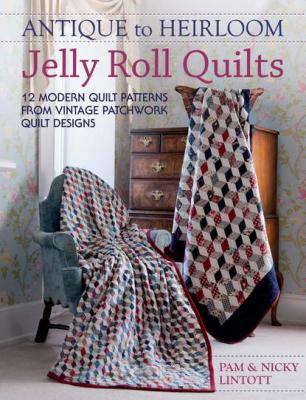Antique To Heirloom Jelly Roll Quilts. Pam Lintott
Читать онлайн.| Название | Antique To Heirloom Jelly Roll Quilts |
|---|---|
| Автор произведения | Pam Lintott |
| Жанр | Сделай Сам |
| Серия | |
| Издательство | Сделай Сам |
| Год выпуска | 0 |
| isbn | 9781446361764 |
The background fabric could be changed to a much darker colour, so the plain squares have more drama. You could feature motif quilting in these squares.
Instead of using plain squares you could use other blocks, such as the snowball block shown in this final layout diagram.
Jewel in the Crown
Antique Inspiration
This is an American Depression-era quilt dating to around the 1930s. Its charming but simple layout is created with machine piecing and its existence may well be due to the entrepreneurial efforts of an American called Isaac Merritt Singer. We have to thank Mr Singer for the fact that so many families had sewing machines by the 1930s. He started the Singer Manufacturing Company in 1865 and came up with the clever idea of allowing families to buy sewing machines by spreading the cost on an instalment plan. This made buying a machine much more affordable to families, particularly those suffering from the economic downturn, and by 1870 the sewing machine had become available to all women, not just the wealthy.
This quilt is a single Irish Chain design with a pretty scalloped edge. The nine-patch blocks alternate with plain squares, making it easy to piece by machine. It is very finely hand quilted with a grid pattern in the nine-patch blocks and filled in with a tulip quilting design and a tulip border. The quilt measures 70in × 87in (178cm × 221cm).
Today’s Heirloom
For our heirloom quilt we decided to use a jelly roll of reproduction 1930s fabrics, combined with a white-on-white fabric for the background. During the 1920s colour tastes were changing and although women still admired the darker, traditional shades they began to seek out lighter, brighter colours. A fresh, pastel look became popular and this is the one we have tried to create with our modern-day interpretation. This cozy and welcoming quilt is so easy to put together and would be perfect for many different décors.
Embroidery experienced a revival in the early 20th century and skilled hand work was often incorporated into quilts. We couldn’t match the exquisite hand quilting in our antique quilt so we chose to longarm quilt a 1930s flower design, which we felt was appropriate. The quilt was made by the authors and longarm quilted by The Quilt Room.
Jewel in the Crown Quilt
Vital Statistics
Finished Size: 69in × 87in
Block Size: 6in square
Number of Blocks: 80 nine-patch blocks and 63 background squares
Setting: On point
Requirements
• One jelly roll OR forty 21⁄2in strips cut across the width of the fabric
• 41⁄2yd (4.10m) of background fabric
• Jelly roll strips are used for the binding
Sorting your Strips
• Choose twenty-five jelly roll strips for the blocks.
• Choose eight jelly roll strips for the binding.
• Seven are spare.
Cutting Instructions
Background fabric:
• Cut eleven 61⁄2in wide strips and subcut each into six 61⁄2in squares. You need sixty-three squares in total.
• Cut twenty 21⁄2in wide strips for the nine-patch blocks.
• Cut two strips 10in wide and subcut each strip into four 10in squares. Cut across both diagonals to form thirty-two setting triangles.
• Cut one 51⁄2in strip and subcut into two 51⁄2in squares. Cut across one diagonal to form four corner triangles. Cutting the setting and corner triangles this way ensures the outer edges of your quilt are not on the bias. You need thirty-two setting triangles and four corner triangles.
Making the Nine-Patch Blocks
1 Using the jelly roll strips allocated for the blocks, sew a jelly roll strip to both sides of a 21⁄2in background strip as shown in the diagram below to make Unit A. Repeat to make ten Unit As. Press seams in the directions shown.
Unit A
2 Subcut each Unit A into sixteen 21⁄2in segments. You need 160 in total.
3 Sew a 21⁄2in background strip to both sides of a jelly roll strip as shown in the diagram to make Unit B. Repeat to make five Unit Bs. Press seams as shown.
Unit B
4 Sub-cut each Unit B into sixteen 21⁄2in segments. You need eighty in total.
5 Choose two segments from Unit A and one segment from Unit B. Sew the segments together as shown to create a nine-patch block, pinning at every seam intersection to ensure a perfect match. Your blocks can be as scrappy as you like. Repeat to make eighty nine-patch blocks.
Make 80
Setting the Blocks on Point
6 Create Row 1 by sewing a setting triangle to both sides of a nine-patch block as shown in the diagram. The setting triangles have been cut slightly larger to make the blocks ‘float’, so when sewing the setting triangles make sure the bottom of the triangle is aligned with the block. Press as shown.
7 Create Row 2 by sewing a setting triangle to each side of a nine-patch block with a background 61⁄2in square in the centre. Press towards the nine-patch blocks.
8 Following the quilt
